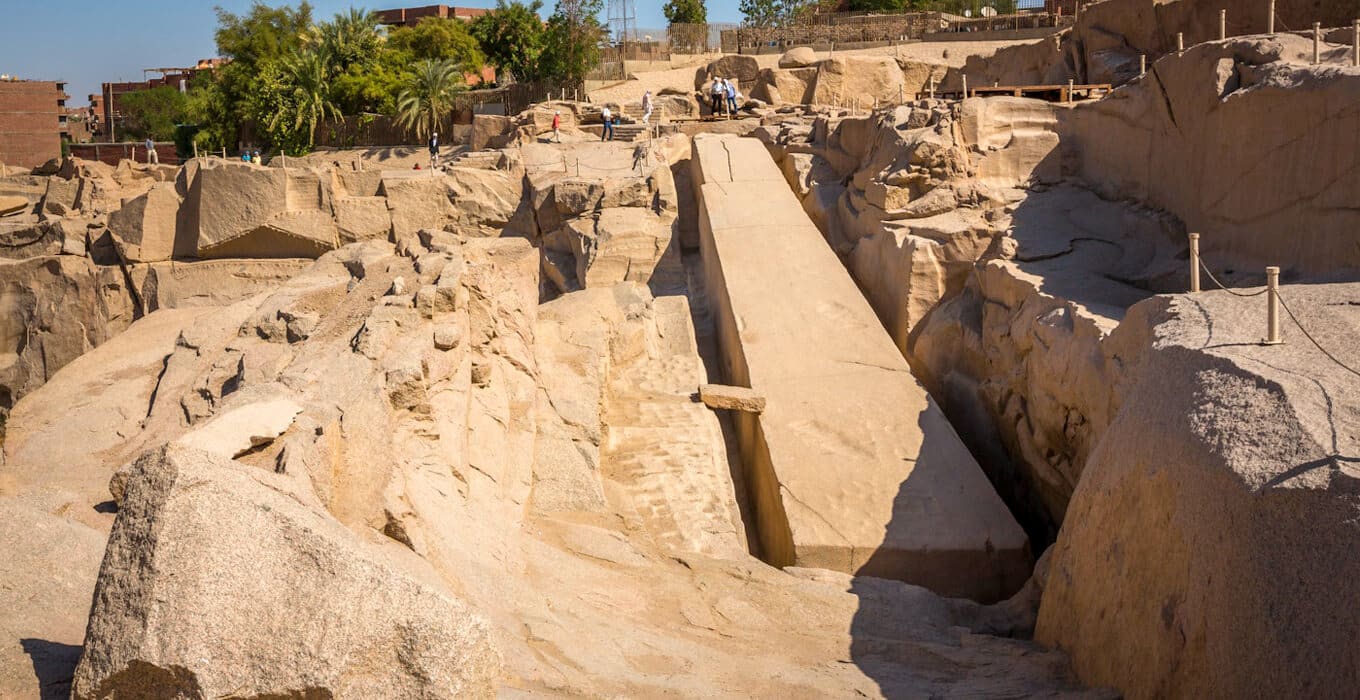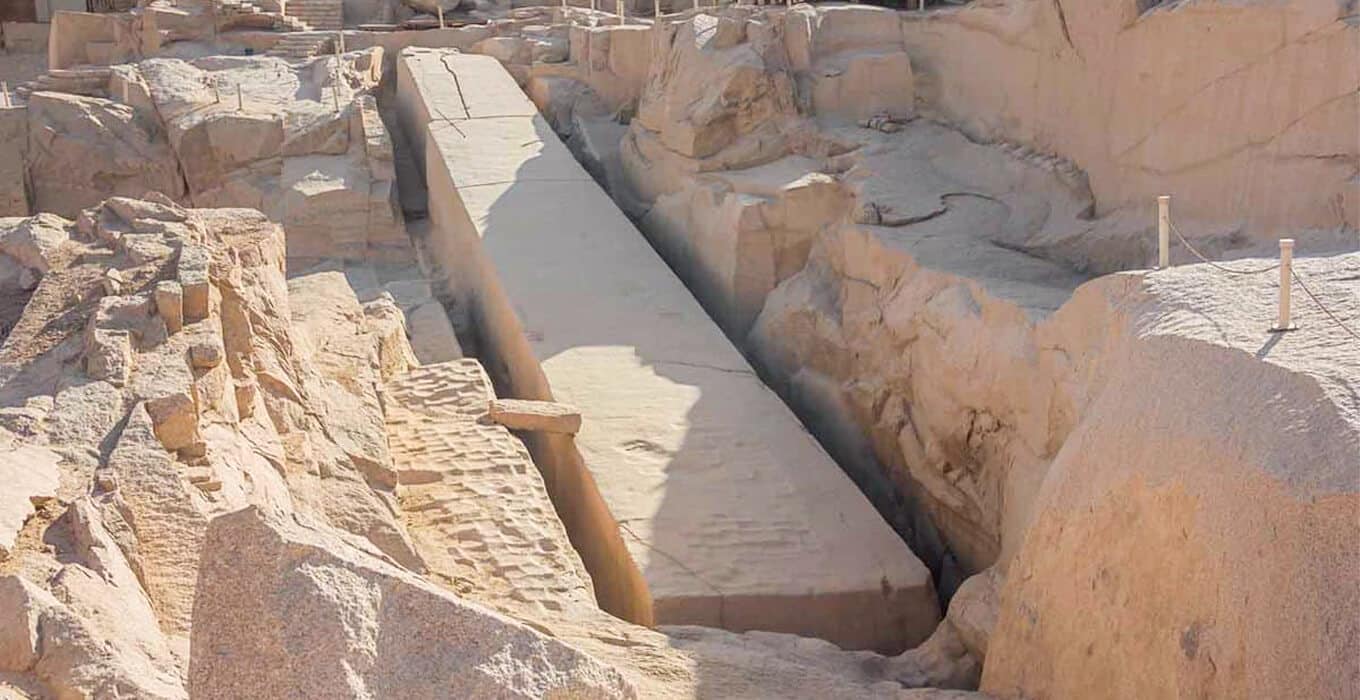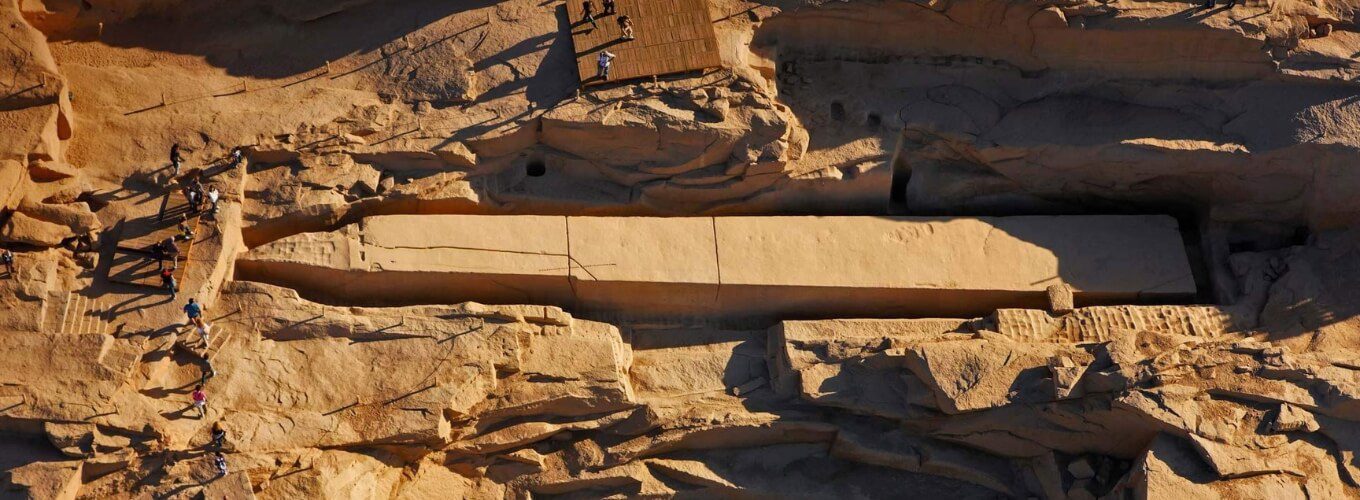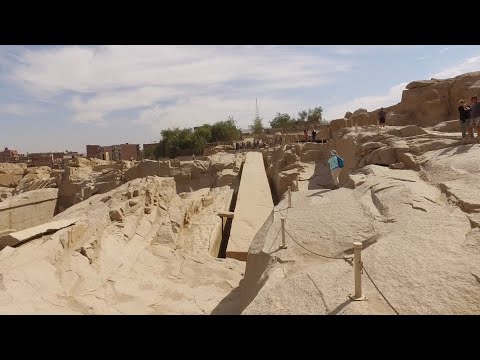Picture a huge granite monument, standing tall at 42 meters high and heavy at 1,200 tons. This is the Unfinished Obelisk in Aswan, Egypt. It’s a huge ancient wonder, hidden in an old quarry. It shows how skilled the ancient Egyptians were in engineering.
Even though they stopped working on it because of cracks, the Unfinished Obelisk still shows their big dreams and skills. It’s a sign of their amazing civilization.
Key Takeaways
- The Unfinished Obelisk in Aswan, Egypt, if completed, would have been the largest obelisk ever constructed, standing at an impressive 42 meters tall.
- This colossal granite monument was envisioned to weigh a staggering 1,200 tons, making it the heaviest obelisk ever attempted.
- The Unfinished Obelisk offers a unique window into the remarkable engineering and construction techniques employed by ancient Egyptian builders.
- While the project was abandoned due to cracks in the granite, the obelisk remains a captivating symbol of the ambition and skill of ancient Egyptian civilization.
- Visitors can explore the Unfinished Obelisk and its quarry, gaining insights into the rich history and culture of Aswan, Egypt.
Unfinished Obelisk in Aswan, Egypt: An Extraordinary Monolith
The Unfinished Obelisk in Aswan, Egypt, shows the amazing skills of ancient Egyptian builders. This huge granite obelisk would have been the biggest ever if finished. It would have been 42 meters (137 feet) tall.
Location and Dimensions
This obelisk is in the Northern Quarries of Aswan, known for its top-quality granite. It’s huge, weighing about 1,200 tons. This makes it the heaviest obelisk ever made.
Significance and Abandoned Construction
The Unfinished Obelisk gives us a peek into ancient Egyptian engineering. Even though it was left unfinished, it teaches us a lot. The project stopped over 3,500 years ago because of cracks in the granite. This shows how hard it was to make such a big stone monument.

|
Statistic |
Value |
|
Planned Height |
42 meters (137 feet) |
|
Estimated Weight |
1,200 tons |
|
Abandoned Construction |
Over 3,500 years ago |
The Unfinished Obelisk in Aswan, Egypt, shows us the amazing skills of ancient Egyptians. It still amazes visitors and experts today.
Insights into Ancient Egyptian Engineering
The Unfinished Obelisk in Aswan, Egypt, shows us the amazing skills of ancient Egyptians. By looking at this almost finished granite monument and the quarry around it, experts have learned a lot. They found out about the tools, methods, and techniques used to make and move huge structures.
The Unfinished Obelisk has clear signs of how ancient stone workers did their job. You can see marks from dolerite pounders used to take the granite away from the rock. They also used a clever way to separate the obelisk by filling small spaces with water-soaked wood chips.
The detailed marks and carvings on the Unfinished Obelisk show the cleverness and accuracy of Egyptian stone carvers and builders. These signs tell us about how they planned and built these huge structures. They give us a peek into the amazing engineering and building skills of the ancient Egyptian engineering and construction practices.
|
Statistic |
Value |
|
Planned Height of the Unfinished Obelisk |
41.75 meters (137.0 feet) |
|
Planned Weight of the Unfinished Obelisk |
Nearly 1,090 tonnes (1,200 short tons) |
|
Estimated Date of the Unfinished Obelisk |
18th dynasty, approximately 1549 – 1292 BCE |
|
Current Weight of the Unfinished Obelisk |
Over 1,200 tons (1.2 million kilograms) |
|
Quarry Source |
Gebel el-Silsila quarry |
The Unfinished Obelisk in Aswan is a clear example of the amazing stone carving techniques and quarrying methods used by ancient Egyptians. It gives us a unique look into their engineering skills and how they built things.
Queen Hatshepsut’s Ambitious Undertaking
Queen Hatshepsut, a powerful female pharaoh, ordered the Unfinished Obelisk during her reign. She wanted to place it at the Karnak Temple. This was a major religious and architectural center in ancient Egypt.
The 18th Dynasty and Karnak Temple
Hatshepsut’s big plans show the greatness of ancient Egypt’s 18th Dynasty. The Unfinished Obelisk was meant to match the Lateran Obelisk at the Karnak Temple. During her time, Egypt was prosperous and culturally rich.
Hatshepsut started many big projects. These projects helped make Egypt a leading power in the area.
|
Fact |
Detail |
|
The New Kingdom of Egypt |
Took place around 1570 BCE – 1544 BCE |
|
Queen Hatshepsut’s Birth |
Around 1504-1508 BCE into Egypt’s 18th ruling family |
|
Hatshepsut’s Accession |
In 1473 BCE, she assumed the title of Pharaoh alongside her 8-year-old stepson |
|
Hatshepsut’s Expedition to Punt |
Her fleet of five large ships traveled over 100 miles eastward to the Red Sea, returning with ivory, skins, ebony, gold, exotic animals, frankincense, and 31 live myrrh trees |
|
Hatshepsut’s Military Campaigns |
She waged successful campaigns against Nubia (Kush) and Syria (Canaan), likely leading her troops into battle herself |
Hatshepsut’s projects, like the Unfinished Obelisk, show ancient Egypt’s greatness in the 18th Dynasty. This was a time of cultural growth and strong female leaders like Hatshepsut.
Quarrying and Construction Techniques Revealed
The Unfinished Obelisk in Aswan, Egypt, shows us how ancient Egyptian builders worked. They left behind clues about their quarrying and construction methods. Archaeologists have found out a lot about how they made these huge rock monuments.
Tools and Methods Used
Ancient Egyptians used special tools and methods to carve the Unfinished Obelisk. They used dolerite pounders, which were harder than granite, to chip away at the rock. They also made small cavities in the rock and filled them with water-soaked wooden chips. This helped them detach the obelisk from the stone around it.
Workers’ Marks and Carvings
Many workers’ marks and carvings are found on the site. They show how skilled and organized the workers were. These markings let us see the lives and work of the ancient Egyptian stonemasons and craftsmen. They worked hard to make these amazing rock-cut monuments.
The Aswan quarry and the Unfinished Obelisk show the amazing skills of ancient Egyptians. Their work still amazes and inspires people all over the world.

Legacy and Enduring Fascination
The Unfinished Obelisk has caught the eye of many. It’s the biggest unfinished obelisk from ancient Egypt. Its size shows the amazing skills of the ancient builders.
This unfinished work shows us the limits of ancient Egyptian building skills. It also shows the big challenges they faced. Now, it’s like an outdoor museum. It lets us feel connected to the past and learn about ancient Egyptian architecture.
The ancient Egyptian monuments, like the Unfinished Obelisk, amaze and inspire us all over the world. They give us a peek into the amazing building skills of the ancient Egyptians. They show how they worked with huge stones and aimed for historical significance.
The Unfinished Obelisk reminds us of the big dreams and hard work of the ancient Egyptians. It shows their creativity and strength, even when things got tough. Its story still moves and motivates us today.
Largest Monolithic Obelisk of Ancient Egypt
The Unfinished Obelisk in Aswan, Egypt, shows the amazing skills of ancient Egyptian builders. If finished, it would have been the biggest obelisk ever, standing 42 meters tall and weighing 1,200 tons.
The Lateran Obelisk, the biggest one still around, is 32 meters tall and weighs 455 tons. The Unfinished Obelisk would have been much bigger, showing the ambition of ancient Egyptian artists. They always aimed for the top in architecture and engineering.
Planned Height and Weight
Pharaoh Hatshepsut started the Unfinished Obelisk over 3,500 years ago. It was meant to be one of two, with the other possibly being the Lateran Obelisk in Rome. Ancient Egyptians used a special method to remove the sculpture from the rock. They put wooden wedges in holes and covered them with water to make them expand.
But the Unfinished Obelisk was left unfinished because of a big crack during its removal from the quarry. They tried to make it into smaller pieces, but it didn’t work. Still, it’s a big deal for visitors and helps us learn about ancient Egyptian stone-cutting skills.
Open-Air Museum and Archaeological Treasure
The Unfinished Obelisk is now an open-air museum in Aswan, Egypt. It shows us how ancient Egyptians worked with stone. The obelisk, still on the rock, shows their skills and the problems they faced.
There are many marks and carvings from the workers. These show how they built such a big project. You can see the tools they used, like grooves, wedges, stone, and abrasive tools.
Now, the Unfinished Obelisk teaches us about ancient Egypt’s amazing achievements. If finished, it would be very tall and heavy. It would be the biggest stone project from ancient times.
This site is a treasure from the past. It shows the big dreams and skills of the ancient Egyptians. It’s a key place for those who love history and travelers.
Symbolism and Mythological Connections
The Unfinished Obelisk in Aswan, Egypt, is very important in ancient Egyptian beliefs. These tall monuments were linked to the “benben,” the first land from the waters at creation. They called the obelisk “tekhenu,” meaning “to pierce the sky.” This shows they saw these structures as the sun’s rays reaching down.
If the Unfinished Obelisk was finished, it would have linked even more to the creation story and the divine sun. Obelisks stood in front of temples, with many theories about their purpose. The Egyptians thought obelisks were homes for the god they honored. They made offerings to these sacred sites during the Ptolemaic Period (323-30 BCE).
Primordial Hill and Creation Myth
The ancient Egyptians believed in a creation myth about the primordial hill. This was the first land to come out of the Nun, the chaos waters. The Unfinished Obelisk was seen as a symbol of creation. It showed the link between the earth and the heavens.
|
Obelisk Statistics |
Data |
|
Largest Obelisk Ever Created |
The “unfinished obelisk” of Hatshepsut, measuring 137 feet (42 meters) and weighing approximately 1,200 tons |
|
Time to Quarry and Shape an Obelisk |
Around seven months in ancient Egypt |
|
Estimated Weight of the Unfinished Obelisk |
Around 1168 tons, significantly larger than the largest obelisk ever erected in Egypt (no more than 500 tons) |
The ancient Egyptians deeply respected the Unfinished Obelisk. It shows how important this monolith is to their beliefs. It still fascinates scholars and visitors today.
Other Obelisks in Egypt
The Unfinished Obelisk in Aswan is the biggest ancient Egyptian obelisk. But Egypt has many other impressive obelisks. They show the amazing skills of ancient Egyptian builders.
At Karnak Temple in Thebes, many obelisks were made by kings like Tuthmosis I, Hatshepsut, and Seti II. The Luxor Temple also has big obelisks made by Ramses II.
In Heliopolis, near Cairo, there’s an obelisk by Senusret I. Ramses II also put up obelisks on Gezira Island and at Cairo International Airport.
|
Location |
Obelisk |
Builder |
|
Karnak Temple, Thebes |
Multiple obelisks |
Tuthmosis I, Hatshepsut, Seti II |
|
Luxor Temple, Thebes |
Obelisks |
Ramses II |
|
Heliopolis, Cairo |
Obelisk |
Senusret I |
|
Gezira Island, Cairo |
Obelisks |
Ramses II |
|
Cairo International Airport |
Obelisks |
Ramses II |
These huge granite monuments are lasting symbols of ancient Egypt’s skills. The Unfinished Obelisk in Aswan is the biggest. But other obelisks in Egypt are also very special.
Conclusion
The Unfinished Obelisk in Aswan, Egypt, shows the ambition and skill of ancient Egyptian builders. It was meant to be huge but was left unfinished. Yet, it tells us a lot about how they built such big things.
This obelisk was the biggest they ever tried to make. It still amazes people today. It reminds us of the limits ancient Egyptian artists faced. It shows us the amazing engineering skills of ancient Egyptian architecture.
The fact it was left unfinished gives us a peek into the problems ancient builders faced. The marks on the site make us wonder about their methods. Researchers are still learning about how they made these huge granite structures.
Ultimately, the Unfinished Obelisk shows us the lasting impact of ancient Egyptian engineering. It shows us the power of human creativity and hard work. It makes us think about what we can achieve with determination and cleverness.
Read our related articles:

